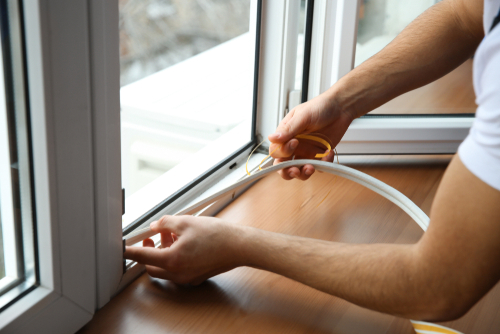How To Keep More Warm Air Inside This Winter
 Did you know that the average American home leaks an amount of air equal to a nearly four square-foot hole in an exterior wall through spaces around windows and doors, and through the walls in its attic and crawl spaces?
Did you know that the average American home leaks an amount of air equal to a nearly four square-foot hole in an exterior wall through spaces around windows and doors, and through the walls in its attic and crawl spaces?
That’s like leaving a window wide open!
The good news is that you can reduce those air leaks without spending a lot of money by weatherizing your home.
Weatherizing is one of most cost-effective investments you can make in home energy efficiency – especially when it’s done in combination with installing high-efficiency heating equipment.
But how – and where – do you weatherize? Let’s take a look.
Weatherization Checklist
Use this list as a reference to the many places to check for air leaks around your home. For more weatherization and air sealing tips and facts, check out the U.S. Department of Energy’s website.
Exterior windows and doors
-
☑ Check for and repair/replace loose panes and broken glass
☑ Caulk around windows and doors frames
☑ Weatherstrip and install door sweeps on exterior doors
☑ eal windows with weather stripping or rope caulk
Attic
☑ Install foam weather stripping around attic door edges
☑ If you have a chimney, seal around it with a high temp sealant and metal flashing
☑ Caulk around plumbing vents that pass through that attic floor and ceiling
☑ Seal gaps between the attic and living spaces with expandable foam or insulation
Basement
☑ Seal gaps between the attic and living spaces with expandable foam or insulation
☑ Seal and insulate accessible ductwork
☑ Caulk around basement windows and external-facing doors
☑ Seal holes and gaps around foundation walls using caulk or foam sealant
Living spaces
☑ Install foam gaskets behind electrical plate covers on exterior walls
☑ Seal cracks and gaps where floors meet exterior walls
☑ If you have a wood-burning fireplace, close the damper when it’s not in use
Outdoors
☑ Use caulk and expandable foam to seal gaps around penetrations through the home’s exterior shell, including HVAC, plumbing, electrical, and water lines
☑ Caulk around all door and window frames
☑ Make sure your dryer vent cover works; if not, replace it
☑ Seal gaps where building materials meet, such as between brick and siding
Looking for more ways to save energy in your southeastern Massachusetts home? Contact the heating pros at W.H. Riley & Son for expert advice on high-efficiency heating system installations and heating service plans for your furnace or boiler.

